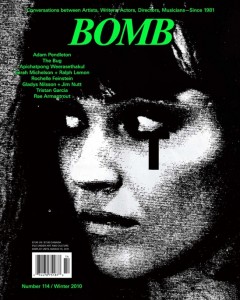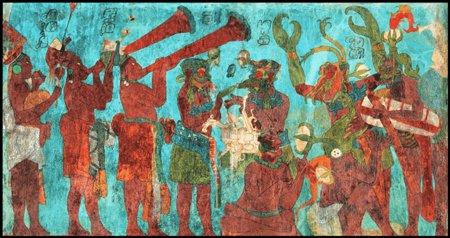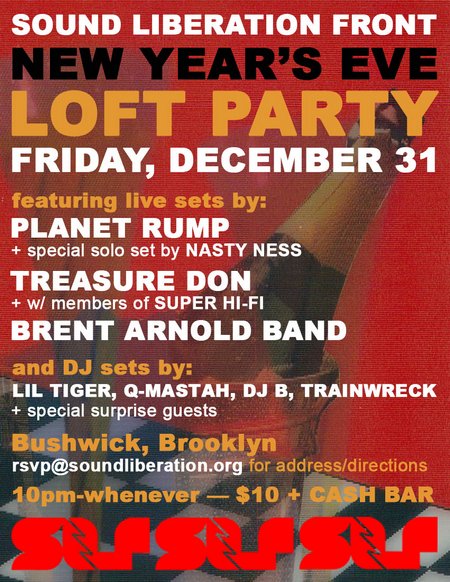I am “special surprise guests.” I’ll be on around 2, stumble on over! rsvp a must.
Month: December 2010
BOMB: THE BUG
cross-posted to Dutty Artz

Check the latest issue of BOMB magazine for an in-depth interview with Kevin Martin AKA The Bug. BOMB has just upped an excerpt & audio clip. Here’s an excerpt of the excerpt:
Jace Clayton: You told me this anecdote: you were at a dub night in London; it was lit by one lightbulb. That’s how I remember you describing it—
The Bug: Oh, yeah. That was again a very pivotal moment for me. Just after I moved to London I went to see Iration Steppas and The Disciples do a “sound clash†together. I didn’t know what the hell to expect. It was at a warehouse in the East End. Literally, there was a sound system on either side of a quite small room with a lightbulb hanging above each, no stage, the audience trapped in the middle, and this head-shredding volume and over-the-top psychedelia. Every mix that each producer was playing would get more and more out-there. At first you would think, Oh, this is a nice reggae tune, and by the end you’d be thinking, Holy shit, this is electro-acoustic madness! People were looking stoned, shell-shocked, or both by what was hitting them. (laughter) It almost altered my internal DNA and how I appreciated music. Before I moved to London, I’d seen a very early Swans show and had realized just how much I loved physical impact in sound.
Photo by Niall O’Brien. Courtesy of Ninja Tune.JC Funny, every time we’ve played together I’ve always tried to leave the building when you were sound checking. It’s massive volume and you take it so seriously; oftentimes if the sound guy is not up to speed, you’ll let him have it. Can you talk about the importance of getting the sound you want in a live situation?
TB Boy, I guess I’ve got a bad reputation for being a bit finicky and demanding. Once you’ve had the experience of what music can be like, if you are a perfectionist and obsessive (like I realize I’ve become), you don’t want to compromise. I don’t follow the idea of making any type of compromise in my life, and definitely not in my music: music is my life. If you’re happy to shut up and let someone water down what you want, then you really shouldn’t be making music. It’s not important enough to you, you know? I believe in a hard-core mentality. Any art should be a pure reflection of the intention of the person making it, and any degree of compromise along the way is just going to lessen the impact of what that person is trying to do. As far as I’m concerned, the physicality of sound is crucial; it takes you beyond intellectual discourse, to very primal, psychological confrontations. I like what it can do to you: it can be seductive, it can be sexy, it can be aggressive, it can fuck you up, it can flatten you, it can wake you up. Intense musical experiences have changed how I live my life, full stop. To some people this may sound a bit over-the-top. My passion is music, and that is reflected in how I approach the live arena. Now, increasingly, when record sales are shrinking, it’s important to leave a statement, to walk away having done something memorable. Volume in itself isn’t memorable; anyone can turn the volume up to 12 and crush someone with it. That’s not impressive. It’s the constructions within the music that are important.
LLEGO LA NAVIDAD: VILLANCICOS, ASALTOS Y AGUINALDOS


You can’t mess with Christmas traditions that start at 160BPM and rise. Dominican merengues navideños are a holiday force!
[audio:https://negrophonic.com/mp3/02 Los Rosario – Esto Ta Bueno.mp3]Any holiday song which concludes with sirens & calls for the Fire Dept. is a ‘success.’
For the current Style/Music issue of the New Museum’s New City Reader newspaper (Daniel Perlin & I co-edited the Music section), I asked one of the smartest music writers around, Carolina Gonzalez (she literally wrote the book on the latino life in NYC!) to guide us through Nuyorican traditions of villancicos, asaltos, and aguinaldos. The results can be picked up at The New Museum, seen on display at a few spots around Manhattan, and downloaded here as a handy PDF.
I’ll post more about our Style/Music issue soon, as it is jam-packed with goodness spanning Luc Sante to DiS magazine! Until then, another holiday merengue stomper to ensure yr Christmas party gets crunk:
[audio:https://negrophonic.com/mp3/03 Toros Band – Llego La Navidad.mp3]Here’s a screenshot excerpt from Carolina’s article in the newspaper’s PDF version:

ELECTROACOUSTIC CAROLS

[Navidad en el Tropico: Los Trovadores de Puerto Rico album cover]
first – next Monday’s radio show will be a two-hour special! so tune in at 6pm EST to hear special guest Marcus Boon discuss his latest book, In Praise of Copying. As he says: “Aside from talking about World Music 2.0, the global rise of Autotune, and how to live in a world of copies without originals, I’m going to play some music: expect Kuduro, Logobi, Saharan psychedelia, Ramadanman as well as some clips from other folks’ mixes and some archival hauntings.”
second – ELECTROACOUSTIC CAROLS was the title of last week’s radio show. In the end I only played 1 or 2 villancicos, but it was a nice hour nonetheless, lots of deep flamenco & oud/vocal pieces:
tracklist: Continue reading ELECTROACOUSTIC CAROLS
ANCIENT MAYAN SUBWOOFERS

Maya temple ruins in Palenque, MX. Photo by Panoramic Images/National Geographic.
National Geographic just published an article presenting evidence that “Ancient Maya Temples Were Giant Loudspeakers.”
“Centuries before the first speakers and subwoofers,” writes Ker Than, “ancient Americans—intentionally or not—may have been turning buildings into giant sound amplifiers and distorters to enthrall or disorient audiences, archaeologists say.”
While the jab ‘intentionally or not’ gives me pause (did they accidentally build an underground rave cave with exceptional acoustics?), the thought of ancient Mayas carving out subwoofers in 600 A.D. is very 2012, very tribal guarachero. The temple ruins at Palenque in central Mexico suggests “a kind of ‘unplugged’ public-address system, projecting sound across great distances” — perfect for a post-oil dance party.
[audio:0030 RITMO_.MP3]The article explains: “The ‘amplifiers’ would have been the buildings themselves, and their acoustics may have even been purposely enhanced by the strategic application of stucco coatings, Zalaquett’s findings suggest. . . ‘We think there was an intentionality of the builders to use and modify its architecture for acoustic purposes,’ Zalaquett said in an email.”
[audio:0022 RITMO_.MP3]It goes on to discuss ChavÃn de Huántar, a pre-Incan maze-like space with similarly strange & disorienting acoustic effects. “For example, stone sculptures seem to show people in the maze transforming into animal-like deities with the aid of drugs.”

Celebratory Mural in the halls of Bonampak: wikipedia
Spaces of dance and celebration seem to be some of the most precarious pieces of urban real estate — hype clubs can fall out of fashion in a season, or, worse get shuttered overnight in capitulation to cop harassment, noise complaints, zoning shifts, all the various pressures of gentrification.
So I love the idea that some of the most enduring structures in the Americas are Pre-Columbian ritual spaces for heightened sound reception and communal celebration. Longetivity! Which Mexican tribal guarachero music also participates in. These MP3s provide some quick examples of the genre very intentionally invoking Aztec and Maya pasts via sound and language. Even the beats themselves underscore a communal function: listened to as stand-alone tracks, they can seem repetitive or simplistic in construction. But it’s music meant to be activated by a dancing crowd and mixing DJ, played, of course, over an appropriately huge soundsystem (with or without electricity).
As I wrote in my Fader feature:
When tribal (“tree-BALLâ€) first started bubbling out of Mexico City around 2005, they called it “tribal pre-Hispanic,†after Ricardo Reyna’s “La Danza Aztecaâ€â€”the first tune to pull pre-Columbian samples into tribal house. This is what “tribal†now refers to: not tribal house, but Tribes—Aztec and “African,†which the music evokes via clip-clopping drum grooves and twee pre-Hispanic melodies. In Mexico City’s massive Zócalo plaza, which forms the new sound’s mythic home, Indians play flutes and drums in Aztec costumes, spicing the city’s unhealthy air with their burnt frankincense. The nearby pirate marketplace of Tepito stocks countless low-bitrate tribal CD-Rs. Rewind 500 years, before the Spanish arrived: Zócalo was the center of Tenochtitlan, the Aztec island-metropolis that happened to be one of the world’s largest cities.
The only reliable now, even one scattered on cheap street CD-Rs, has the weight of history close at hand. This sudden teen musical phenomenon self-consciously stretches back to the days of these Palenque raves.

Erick Rincon and Sheeqo Beat in Erick’s studio. photo by John Francis Peters for The Fader
[audio:0139 KUA.MP3]DJ Antennae – Nawy Kuahutli (anybody know what this Nahuatl phrase means?
“If you can create a mysterious sound that seems otherworldly,” says British archeaologist Chris Scarre, “you’ve created something that is a very powerful and intriguing element in the ceremony.” “3ball Monterrey, putos!!,” he added.
IN PRAISE OF COPYING

One of the most interesting books I read this year was Marcus Boon‘s In Praise of Copying (free PDF download). It’s a philosophically broad consideration of copying, informed by Buddhism – which has long considered essencelessness — and a really good soundtrack. Published on Harvard University press, it gives me hope for akademic writing: Boon’s prose is lucid and approachable, whether discussing “Louis Vuitton” bags or Taoist views on the ecology of copying…
Here’s an excerpt. After describing a breakdance battle between two dancers with highly divergent styles, Boon writes:
Of course ‘style,’ including hip-hop style, has long been integrated into the capitalist marketplace — and there could be no capitalist market at all without very particular organizations of appropriations of copia abundance. But to see style, and for that matter ‘copying,’ as mere epiphenomena of capitalist production is to invert things, and to radically underestimate the power of these forces. The power of hip-hop, and the five elements, which are five ‘styles’ of being in the world, constitute five types of magic, if you like — five ways of transforming things, and therefore five ways of changing what gets called a ‘person’ and what gets called a ‘world.’ I would like to think, though I can’t prove it, that folk cultures have always had this power, have always discovered it for themselves, insofar as folk cultures are always cultures to whom nothing belongs, from whom everything is taken.
The New Yorker described the book as: “. . .not an investigation of the ethical dilemmas of copying but a Gertrude Stein-like affirmation of the mimesis that happens everywhere and everyday. Boon sees copying as fundamental to existence, part of ‘how the universe functions and manifests.’ . . . Boon encourages us to rethink terms like ‘subject,’ ‘object,’ ‘different,’ and ‘the other,’ in order to “account for our fear of and fascination with copying.”
Marcus Boon has a great radio voice and will join me on WFMU 91.1 FM NYC next Monday, December 27th, 6-8pm, to discuss In Praise of Copying and share some music!

FRIEZE: MEXICO CITY REPORT

I bang my fist against the sheet-metal grate. I’m in Mexico City’s historic Centro neighbourhood, a grid of beautiful, busy streets whose structural regularity is pushed into chaos by dense flows of automobiles, people, sounds, smells, all compressed and vivid and hyperkinetic by day, often unnervingly empty at night. Another knock. No answer. I open the dusty metal door.
We spill into the Bósforo, an undecorated clandestine bar specializing in high-proof homebrew spirits. Tonight El Nicho, a ‘virtual space with physical manifestations’ that imports experimental music, has staged its monthly pop-up. . .
Thus begins an essay I wrote for the new issue of Frieze Magazine’s Mexico City report. You can read it here; the page begins with Gabriela Jauregui’s piece, scroll down for mine.
Along with our words, you can listen to “an exclusive playlist for Frieze, curated by Eric Namour of El Nicho Experimental.”
MUDD FM

Radio tonight! We’ll have some seasonal cheer in the form of aguinaldos y villancicos, some exclusive cumbia jams from Capitol K, a bit of Enrique Morente (R.I.P. – post coming soon!) and Leafcutter John — Over the weekend I realized that listening to good flamenco is strangely analogous to listening to good electroacoustic music – if you surrender, each can take you so deep…
And I nearly forgot to post up the stream from last Monday’s show:
Subscribe to the Mudd Up! podcast if you prefer downloadable versions, issued a week after FM broadcast: ![]() ,
, ![]() Mudd Up! RSS. Also useful: WFMU’s free iPhone app
Mudd Up! RSS. Also useful: WFMU’s free iPhone app
tracklist:
MINNEAPOLIS WARMUP

Minneapolis! Here we go, this Tuesday, December 14th: DJ /rupture live at the Southern Theater. info & tix.
+ + +
Mudd Up! broadcasts today on WFMU 91.1FM NYC 7-8pm EST. And don’t sleep on Lamin Fofana’s 3-hour radio show yesterday!
NEW MUSE LAST NEWS

Depending on how you hold it, the New City Reader is either a a temporary newspaper that will be published from October 6, 2010 to January 9, 2011 as part of the Last Newspaper exhibition at the New Museum, or a performance-based editorial residency which happens inside the museum.
I’m guest-editing part of the MUSIC/STYLE section. I have assembled a World-Class Crew of Contributors & am super excited to escort their brilliance into print. The NCR editorial team will meet inside the New Museum today around 6pm. You are welcome to come heckle us, suggest things, share tea + cookies + a mate gourd. (entrance is free after 7pm today)

Past editions of New City Reader can be viewed here, and you can grab the current issue at the museum itself. Follow NCR on Twitter, although Twitter hates wikileaks and censors trending topics in yet another weird devolution of transparency (so much for algorithmic populism). So. Where were we? Shopping for electronics on Canal St? Close. We were on Bowery. Inside a museum round the corner from the flophouse.
New City Reader: Public space, urban space, information space, wrapped up with the finger-smudging timeliness of an experimental weekly.

